What You Should Know
What You Will Learn
- What the musical alphabet is
- Strategies for determining the pitch of each note
- Exercises for memorizing the notes on the guitar
Learning the Notes on the Guitar
Learning the notes on the guitar is the first step in learning music theory. You need to know the notes all over the fretboard in order to understand the concepts and to do the exercises given on this site.
The Musical Alphabet
The musical alphabet consists of the letters A, B, C, D, E, F, and G. The alphabet starts over with A after you get to G. The image below illustrates this. Each A is shown in orange to make it easier to see how it repeats.

Using only the notes A, B, C, D, E, F, and G, there are two frets between each note and the next one, with the exception of B to C and E to F. There is only one fret in between these notes. For example, if you start on A and want to go to B, you go up two frets. On the 3rd string, this is the second fret (A) to the fourth fret (B). If you want to go from the B to C, you move up one fret to the fifth fret.
How Notes are Arranged
Pitches are arranged on the guitar in a specific pattern. There are certain aspects of this that may help you in learning the notes. You don't necessarily need to learn all of these at first, but knowing the basics of how the notes on the guitar are arranged will make it easier to learn where the notes are. Note that these concepts will only make sense if your guitar is in tune.
Most Pitches Occur on More than One String
There are certain pitches that occur on more than one string. To see how this works, play the fifth fret on the sixth string and then play the open fifth string. The basic rule is that if you play a note on a string, you can find the same note five frets up on the string right below that one. Here is how this works with A on the fifth and sixth strings:

This works for all adjacent combinations of strings except for the second and third strings. Here, the distance will be four frets. Play the fourth fret of the third string and then play the open second string. These will be the same pitch. This works when both pitches are fretted as well. For example, play the fifth fret on the second string and go up four frets on the third string to the ninth fret. These notes are the same.
If you have a guitar with twenty-four frets, there is one note that occurs on all six strings. The note is E, which is the pitch of the open first string. Below is the location of this pitch on each string:
- 6th string: 24th fret
- 5th string: 19th fret
- 4th string: 14th fret
- 3rd string: 9th fret
- 2nd string: 5th fret
- 1st string: open
The tablature below shows where this E is found on each string:

Every pitch on the guitar other than this E will occur anywhere from one to five times. How many times a pitch occurs will depend on how high or low the pitch is. In general, the higher a pitch is, the more times it will occur on the guitar.
Octaves on the Same String
Try playing the open low E string and then play the twelfth fret on the same string. Do you notice a similarity in the sound? One pitch sounds higher than the other, but there is something familiar about both notes. This is because the pitch of both notes is E. One E just happens to be an octave higher than the other. If you go up twelve frets from a fret, you will get a note that is an octave higher than the note you are playing.
Without getting into too much theory, an octave is a higher or lower version of a particular pitch. Every pitch has a frequency. Doubling this frequency will result in a pitch an octave higher, while halving the frequency produces a pitch that is an octave lower.
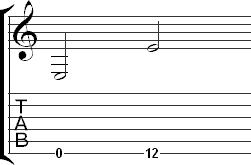
Try this with only fretted notes by playing the second fret on the fifth string. Playing twelve frets above this at the fourteenth fret will give you a note an octave higher. You can also do this in reverse by going down twelve frets.
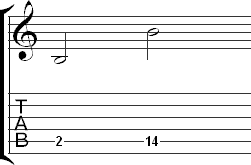
Octaves on Different Strings
There are several ways of playing octaves if two strings are used instead of one.
Octaves on Adjacent Strings
Playing a note on a string and then playing a note up seven frets on the next highest string will produce a note an octave higher. The example below shows several octaves on the fifth and sixth string:
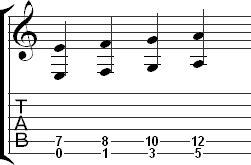
This concept works on all other adjacent pairs of strings except for the second and third string pairing. For the second and third string pair, you need to go up eight frets. Below is an example of several octaves on this pair of strings:
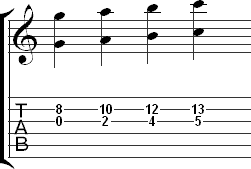
Octaves on the fourth and sixth strings and the third and fifth strings.
Octaves can be played on the fourth and sixth, and the third and fifth strings by fretting a note on the lower string and playing a note two frets up on the higher string. For example, playing the first fret on the sixth string and the third fret on the fourth string.
Here is an example of this concept using the fourth and sixth strings:
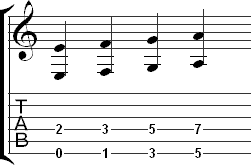
Octaves on the second and fourth and the first and third strings
Octaves can be played on the second and fourth strings, and the first and third strings by playing a note on the lower string and going up three frets on the higher string. For example, the second fret on the third string and the fifth fret on the first string are an octave apart.
Several octaves on the first and third strings are shown below:
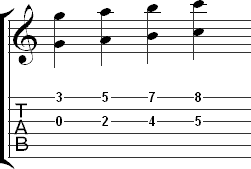
Octaves on the second and fifth strings or the first and fourth strings
Octaves occur between the second and fifth, and the first and fourth strings by playing a note on the lower string and playing a note two frets back on the higher string. For example, playing the third fret on the fifth string with the first fret on the second string will produce an octave.
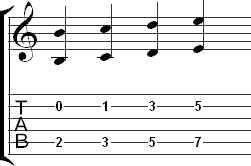
Octaves on the 3rd and 6th strings
Octaves can be played on the third and sixth strings by playing a note on the sixth string and playing a note three frets back on the third string. For example, playing the fifth fret on the sixth string with the second fret of the third string. Here are several octaves on this pair of strings:
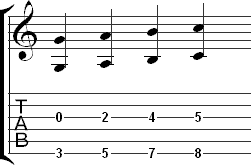
Using These Concepts to Learn the Notes
Finding any pitch on the guitar should be relatively easy using these ideas about the layout of the guitar. Once you know the notes on even a single string, you can use octaves or unisons to find every other pitch on the guitar. For example, if you know the notes on the low E string and want to find out what the note at the fifth fret on the fourth string is, you could use the octave shape for these two strings. You would find that the fifth fret on the fourth string is an octave above the third fret on the sixth string. Since you already know that the third fret is a G, you should be able to determine that the fifth fret on the fourth string is a G also.
How to Learn the Notes on the Guitar
Natural Notes
The natural notes should be learned first. All of the other notes will be learned later because they are more easily understood in the context of things like scales and keys.
A natural note is any note that isn't sharp or flat. A note that is sharp or flat will have a symbol after the letter. Sharps and flats are two kinds of accidentals. For the purposes of this lesson, a natural note is considered to be any note that doesn't have a sharp or flat symbol after it. Therefore, A and G would be natural, while C# and Bb would not.
The E Strings
The first step in learning the notes should be to learn the notes on the two E strings. Every fret on these strings will be the same pitch, although in a different octave. You will know one-third of the notes on the guitar after learning these strings. Try learning the notes without referring to a chart at all. This is more difficult than memorization, but will be worth it.
You will need to use the musical alphabet to do this. Here is how this would work starting on the high E string:
- 1. The open string is E.
- 2. The next note in the musical alphabet is F. If you keep in mind that going from E to F in the musical alphabet is the distance of one fret, you should know that F is on the first fret.
- 3. G is the next note in the alphabet. There are two frets between F and G, so G will be on the third fret.
This concept can be continued all the way up the neck and should be applied to all the strings as you learn them.
Learning the Other Strings
Once you have memorized the notes on the E strings, start adding a string at a time until you have learned all six strings. Use the musical alphabet to help you learn these strings. You may also use octaves and unisons to help determine the pitches.
Start by learning the notes only up to the twelfth fret. Any notes above this can be determined easily by figuring out the pitch of the note twelve frets lower. With enough practice, you should be able to immediately name the pitch of any fret on the guitar.
Fretboard Diagram with the Notes Labeled
A fretboard diagram is a visual way of representing the guitar neck. The horizontal lines represent the strings. These lines are labeled with the pitch of the open string that corresponds to each line. The vertical lines represent frets. These are labeled at the third, fifth, seventh, ninth, and twelfth frets to make it easier to find each fret.
A chart of the notes on the guitar up to the twelfth fret is given below. Use this as a guide to check yourself rather than trying to memorize it. The concepts given previously should be used to learn the notes instead.
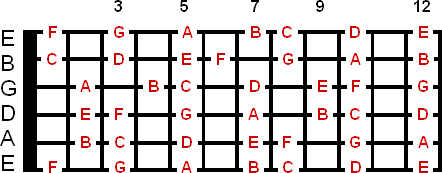
Exercises for Learning the Notes on the Guitar
- 1. Try finding all occurrences of a certain pitch on all strings. For example, try to find every E on the guitar.
- 2. Find all unisons of a certain note. For example, if you start with the twelfth fret E on the sixth string, you can find this same pitch at the seventh fret on the fifth string and the second fret on the fourth string.
- 3. Pick a fret number and name the notes on each string at that fret. For now, skip any note that isn't natural.
- 4. Starting with the open string, play each natural note up the string and name each note as you play it. Do this on each string.
